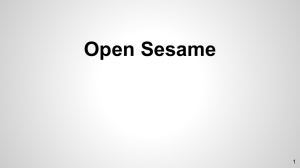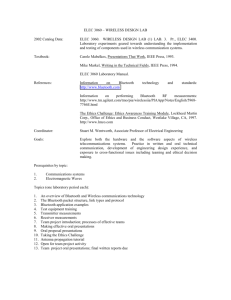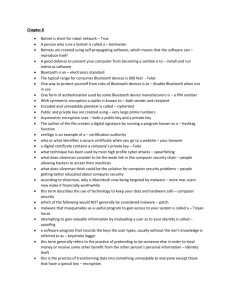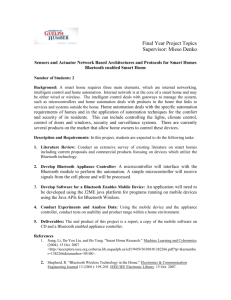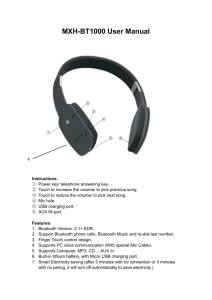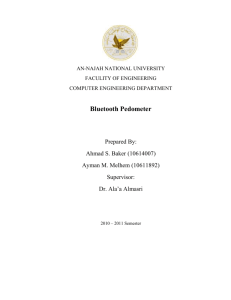JFC's notes in PowerPoint
advertisement
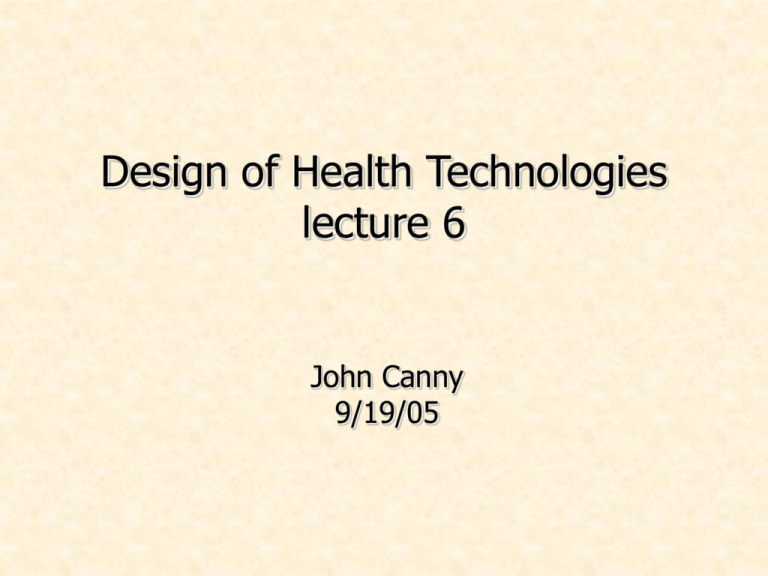
Design of Health Technologies lecture 6 John Canny 9/19/05 Lecture Outline Sensing for health: Vital signs sensors Disease sensors Environmental sensing (mention only) Networking: Requirements for health sensing Wired (serial/USB) and wireless (Bluetooth) systems for sensing, cell phones etc. Vital Signs/Basic Health sensing Vital Signs: Body temperature Blood pressure Pulse (pressure) Pulse (oximetry) Pulse (ECG electrical) Stethoscope (acoustic chest measurements) Pedometers (walking, running) Weight/Body fat Disease Monitoring Asthma Diabetes – – Blood Glucose Non-invasive methods Heart problems – EKG monitoring Environmental Sensing (later) Air Quality – – – – Particulate matter Sulfur oxides CO CO2, Nitrogen oxides, hydrocarbons… Water Quality – – – – – Bacteria: Typhoid, Cholera, E-coli Protozoa: Cryptosporidium and Giardia Viruses: Hepatitis, many types of diarrhoea Helminths: Parasitic worms, Ascariasis, Hookworm Arsenic: responsible for > 200,000 deaths/year Basic Health - Temperature sensors Simplest form of sensor. Quite a few of these on the market, several have PC interfaces. Electronic versions use small thermal sensing elements – fast response. Omron thermometer Pasco PasPort temp. sensor Blood Pressure Monitors The most accurate versions are arm cuff models. There are also finger, or wrist-style models. But location relative to heart height is critical. Latest wrist models include smart sensing to position at the correct height. Omron wrist, arm and finger models Pulse pressure sensing Pulse sensing is normally done by blood pressure monitors, but they require high pressure inflation – enough to halt blood flow – and are not suitable for continuous monitoring. Continuous pressure monitoring can be done on many parts of the body, e.g. the waist: Vernier respiration belt Pulse oximetry Pulse oximetry. A light source/sensor on a finger senses light transmission at 650nm and 805nm. These wavelengths are absorbed selectively by oxygenated and non-oxygenated blood. An oximeter signal varies at pulse rate. ECG-based heart rate Electrical signals can be used to determine heart rate. Polar makes several of these devices with wireless interfaces, and the raw data can be captured and used in exercise monitoring. Polar E600 wrist monitor Polar/PasPort wireless exercise ECG sensor Polar IR/PC interface Electronic Stethoscopes A sound transducer connected to a stethoscope head is a very convenient form of the traditional stethoscope. The electronic version can provide amplification, recording, and minimizes artifacts due to cord contact with clothing etc. Wireless (Bluetooth) Stethoscope Head Intel Physician’s Tablet Exercise pedometers Accelerometer-based sensors detect leg motion. Sensor typically mounted in the shoe or at the waist. Suunto’s T6, Footpod and X9i Fitsense pacer and bodylan Omron BodyMedia BodyBugg Electronic Weight/Body fat Scales There are several weight scales on the market with digital interfaces. Tanita developed a scheme called BIA to estimate body fat as well, and several other manufacturers followed suit. BIA is “Bioelectrical Impedance Analysis”. A&D Lifesource scale with RS232 Tanita body fat scale Disease Monitoring - Asthma The Lancet paper in the readings argues that regular cell phones can be used for Asthma breath monitoring. Ideas: a regular cell phone can be held against the throat, Or a dedicated wireless microphone could be attached near the throat for full-time monitoring. Wireless headsets are an option, or dedicated microphones… Jabra, Motorola, etc. Asthma - Breathing monitors Spirometers directly measure breath flow. They can be used for live measurements into a PC. Vernier Spirometer Asthma - Breathing monitors Electronic flow meters that store readings are very useful for Asthma diaries. It has been shown that children door a poor job of manually maintaining their diaries. Micromedical SpiroUSB Spirometer Ferraris Koko electronic, recording flow meter Micromedical MicroDiaryCard recording Spirometer Diabetes The most direct method is blood glucose measurement. A small blood sample is taken by piercing a finger or arm, and analyzed in a handheld meter. LifeScan OneTouch blood glucose meters. All of these support PC uploads via a serial (RS232) cable. Diabetes – non-invasive methods The Glucowatch uses a method called “reverse iontophoresis” – a small voltage is applied to the skin which draws out intercellular fluid (with glucose in it). The fluid reacts with a gel in a disposable pad, and causes another electrical signal that measures glucose. Received FDA approval in 2002 Extremely valuable for high-risk patients But readings affected by many factors, perspiration etc., not for everyone Requires (expensive) replaceable pads Company (Cygnus) sold this year Glucowatch G2 – device future uncertain Diabetes – permanent monitors The best long-term approach seems to be implanted sensors that are accessed wirelessly from outside the body. Many companies (and labs) are working on this. Craig Grimes (Penn. State) developed a magneto-elastic sensor with a polymer coating that responds to Ph (acidity). An additional layer (glucose oxidase) produces acid in the presence of glucose. This sensor, and the electronics to access it, would be extremely inexpensive. Aside – magneto-elastic sensors Grimes’ group has also demonstrated that these sensors can be tailored to specific pathogens – e.g. disease agents in humans, or in contaminated water. The extremely low cost of the sensors and reader electronics opens up many opportunities for environmental health testing in developing regions. Work is needed on two fronts: Sensor chemistry – tailoring materials that respond to specific agents Reader electronics – reading the sensors requires electronics with high integration for low cost (e.g. systems-on-a-chip) , or modifications to existing SOC hardware (e.g. rfid tag reader chips). ECG (or EKG) ElectroCardioGram ECG signals are the electrical traces of heart muscle action on the chest. ECG sensors are normally “3-lead” or “12lead” (actually 10 electrodes). An ECG signal is quite strong (1mV) but may be immersed in noise from AC appliances, so must be amplified carefully. 3-lead Vernier ECG amp. PasPort amp. Single ECG cycle Systems iMetrikus MediCompass HealthHero’s Health Buddy Summary of sensing needs The sensors we described so far fall into a few classes: Discrete readings: Blood pressure, pulse, temperature, weight, body fat, flow (asthma), blood glucose (diabetes). Signal capture: Pulse oximetry and pulse pressure (waveforms), EKG, stethoscope readings, breath sounds. Monitoring: Repeated readings of one of the above, with checking for measurements outside a safe range. Summary of sensing needs Discrete readings: Blood pressure, pulse, temperature, weight, body fat, flow (asthma), blood glucose (diabetes). These are analog readings, accurate to a few %. A digital representation of 8 bits or more should be fine. Aside: many existing discrete reading devices support recording and data transfer over serial (RS232) links. Signal capture: These signals are either in the audio range (breath sound, stethoscope), or slightly below it (pulse waveforms, EKG). Audio capture (without loss of lower frequencies) should be fine. Precision is not completely clear – the ear is very sensitive. At least 10 bits. Networking Once upon a time, There were just cables… Keyboard, Mouse, Video, Parallel,… Serial (RS232) cable Audio cable Serial connections Serial Cables connect two devices symmetrically like this: Tx = transmitted data Rx = received data Serial ports traditionally support speeds up to 19.2k bit/sec (RS232) but are often used at higher speeds (up to several Mb/s) over short distances. Traditional serial ports are fast disappearing on computers, but as we saw still exist on many medical devices. USB (Universal Serial Bus) USB was the first answer to the proliferation of cables, designed to replace serial, parallel, audio, and other cables. USB is a 4-wire serial bus with a power (+5 volts) wire. USB offers speeds of 1.5Mb/s, 12Mb/s and 480Mb/s. USB is a difficult protocol to use directly, but for general sensor use, it is easy to use a USB/serial cable or bridge chip. Most such bridges use either Prolific or FTDI chips. FTDI USB/serial bridge. Up to 3Mb/sec. Drivers for Windows, CE, Mac, Linux. Presents a virtual COM port. USB for Audio There are also several USB Audio chips. You install a custom driver on the host computer, and the USB sound device appears as a Windows (or Linux, or Mac) sound device. The downside of this is that you have to do this install for every device you might use the USB sound device with. C-media single chip USB Audio system Bluetooth Bluetooth is a wireless cable replacement standard. After a slow start, Bluetooth technology is taking off. Sales for 2005 should exceed 200 million units, and is roughly doubling each year. Bluetooth comes in two flavors: Class 2: for personal devices or in-vehicle use, around 1020m (try 10-20 feet in practice) Class 1: For longer range up to 100m, e.g. in a household or office. Bluetooth Data Rates Bluetooth also comes in two versions. Version 1 (usually you see 1.1 or 1.2) has data rates up to 723 kb/s. Version 2 (aka EDR or Extended Data Rate) triples the data rate up to about 2 Mb/s. Bluetooth shares the 2.4GHz spectrum with WiFi (802.11a,b,g etc.). Bluetooth Profiles One of the most useful innovations in the Bluetooth standard is the use of device profiles. A profile is an abstract device spec. that has to be supported at both ends of a connection. If you like, it’s the kind of cable(s) that that Bluetooth connection supports. Each connection can support several profiles at once. Profiles eliminate the need for custom drivers on the host, and allows a Bluetooth device to connect to any host (PC, PDA, cell phone) that supports the profile(s) it uses. Bluetooth Profiles Bluetooth Stack The message here is that Bluetooth is hairy – like TCP/IP. Older Bluetooth chips only provided HCI functionality. Now they go up to the application layers: SPP, DUN, Headset. Bluetooth Chips - CSR Cambridge Scientific Radio (CSR) manufactures a large number of Bluetooth chips, probably more than half of those shipped. This is a diagram of their Bluecore2 series. This chip fits in a 1cm2 package Bluetooth Modules – Free2Move Bluetooth modules add the components needed to make a working radio: crystal, antenna, flash memory. The current generation of modules measure about 1”x0.5” w/ antenna. Free2Move (Sweden) has some particularly interesting modules based on CSR BlueCore2-flash chips with audio. This radio offers a functioning SPP for serial data, a 15-bit audio channel, and another 8-bit A/D channel. More Bluetooth Hardware Cambridge Scientific Radio (CSR) chips (in most peripherals) BlueCore2 chip Bluetooth v1.1, 16-bit XAP2 processor, A/D, audio options BlueCore3 chip Bluetooth v1.1-1.2, XAP2 processor, audio DSP option BlueCore4 chip Bluetooth V2.0, XAP2 processor AT&T Broadcom chips (in many PC + PDAs) BCM2040 Bluetooth v1.1-1.2, 8-bit 8051 processor BCM2037 Bluetooth v2.0 with audio, 16-bit ARM7 processor BCM2045 Bluetooth v2.0 host side chip Class 2 Modules (with antenna) Free2Move FM03AC2 Bluetooth v1.1 qualified, SPP, 15-bit audio + 8 bit A/D Taiyo Yuden EYMF2CAMM-XX Bluetooth v1.1 qualified, serial port profile BlueGiga WT12 Bluetooth v2.0 EDR qualified, serial port profile + PCM Class 1 Modules (no antenna) Free2Move FM2M03C1 Bluetooth v1.1 qualified, SPP, 15-bit audio + 8 bit A/D BlueGiga Wrap Thor 2022 Bluetooth v1.1 qualified, SPP, DUN, OBEX, HID Developing with Bluetooth The newest modules make it pretty easy to go wireless. Most modules can be used as serial cable replacements. The next simplest step is to add a microprocessor to act as controller (PIC etc.), using the module’s serial profile. But since new BT chips have a powerful, energy-efficient processor on-board already, this is rather wasteful. You can develop for the native processor, but you will need to buy some expensive development tools. CSR and some module vendors provide virtual machines so your code can’t void the module’s qualification. Bluetooth-to-phone To call out from a sensor using a Bluetooth cell phone, it may only be necessary to use the phone’s “DUN” (Dialup Networking) profile. The sensor becomes the master of the connection. No code needed on the phone! Otherwise there are several programming platforms available for phones: Java, BREW, Symbian. BREW is the programming environment for CDMA phones (Qualcomm, Sprint, Verizon,…). Fast and flexible, but you need another expensive development environment (for ARM processors). Project work Please write down a project idea to be handed in next time (Wednesday). Project work starts next week. Next Time Jeff Newman, director of Sutter Health Inst. for Research and Education is the guest speaker. Reading online about telehealth in Finland. What assumptions does this paper make about the application of telehealth? What technical innovations would improve the situation?


